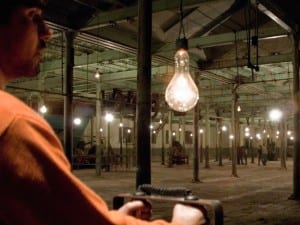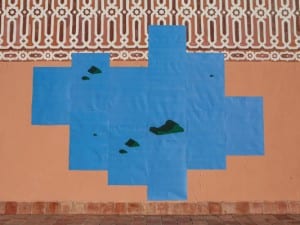The 12th edition of the Sharjah Biennial, in the UAE, curated by Eungie Joo, opened on 5 March to a relatively small exhibition of 51 artists that were representative of the region and from across the globe. Its open-ended theme titled The past, the present, the possible, allowed for a wide selection of works that were the most persuasive when history and nostalgia served as important sources to inspire and empower a new generation of artists. Expressed in minimalist forms, the best works came together when the recollection of the past in the Middle East reclaimed what was once glorious, and provided sufficient grist to conjure recent political strife and the dismemberment of social and family life.
In this respect, Argentine artist Adrian Villar Rojas’ stellar site specific installation Planetarium, 2015, located in the Kalba Ice Factory more than an hour outside Sharjah was perhaps the most stirring evocation of the landscape, its ancient historical ties and the evanescence of time. Large rectangular cement columns of different heights were layered with exuberant striations of colour as well as detritus from the local surroundings. Shells, plants, sand, coconuts and dead birds protruded from these pillars spread across 2400 square feet evoking the cycle of life, decomposition and death in a work of astonishing beauty. Both gritty and visceral, Rojas’ installation suffused with relics of the oldest civilisation related to the delicacy of Rheim Alkadhi’s hair sculptures, Hairs from the Hairbrushes of Palestinians, 2013, made from Palestinians struggling to reclaim their history of place and belonging. Working within a framework of war and occupation, Alkadhi’s fragile compilations recalled temporality, hardship, and conflict since the beginning of time.
For Rayyane Tabet his daunting wooden boat, Cyprus, 2015, hung in the middle of a large space presented grueling memories of the past with great profundity. This minimalist yet powerful artifact referenced the boat his father used to attempt to escape from Lebanon with the family. Infused with a deep sense of loss, pain and nostalgia, Tabet used memory to transform the past and trauma into a new experience of identity and history. Similarly, in Tabet’s Steel Rings, 2013, arranged in an entire wing of the Sharjah Museum, multiple rims of a pipeline built in 1946 to connect three countries resonated with longing for a prior era of political and geographical harmony. History becomes rife with evocations of restrictions, barricades, secrecy and communication in Mexican artist Damian Ortega’s Talking Wall, 2015, constructed in the manner of the ancient fossilised coral barrier. Inspired by the abandoned heritage village of Al Khan, Ortega’s architectural site reverberates with the depth of Tabet’s sculptures.
For many artists, this genre of nostalgic art enables the repossession of Islamic culture. Pakistani artist Lala Rukh’s serigraph prints presented the timelessness of ancient Mughal gardens. In Sigiriya, 1993, Rukh consecrates a bygone era by highlighting an aerial view of the geometry and architecture of the gardens with gold dust. In the same way, Leonor Antunes from Portugal and Thai artist Rikrit Tiravanija devise alternate versions of Islamic beauty. Antunes’ immersive creation of circular floor mats that recall palm mats from a mud brick tomb of 150 B.C., combined with her veil like floor to ceiling threaded screens imagine new forms of traditional exquisiteness. Tiravanija’s equally engaging courtyard of an Islamic rose garden in which rosewater is distributed from constructing a rosewater distillery seen in the Museum of Islamic Civilization recreates the artist’s trademark communal interaction in a serene and sublime setting.
Nostalgia becomes an extremely powerful tool of resistance especially in the context of capitalist expendability for Faustin Linyekula and Ahmad Ghossein. Linyekula’s dynamic performance Le Cargo, 2011, that combines music, dance, and narrative reinstates the significance of his identity and culture through decades of war and dispossession in the Democratic Republic of Congo. Ghossein’s 37minute video The Fourth Stage, 2015, tracks fading tradition through the gradual but tragic disappearance of a magician the artist worked with through his childhood in southern Lebanon. By including picturesque scenes of the countryside with gigantic modernist sculptures built on the borders of rural dwellings, Ghossein alludes to the pull and tension between an idealistic past and a technologically driven present.
Ultimately, regardless of the debate about whether nostalgia as a conceptual conceit is as Paolo Magagnoli points out in his essay, Critical Nostalgia in the Art of Joachim Koester, “progressive or reactionary, critical or ideological, generative or sterile,” these works in the Sharjah Biennial bring one’s attention to what has been lost, and reactivate one’s interest in holding on to what is slipping away. Nostalgia not only enables artists to produce the past with a new sensation and the present with more insight, but it also prompts inventive, transformative narratives through which we can recreate and interpret our own versions of the world.
Sharjah Biennial, until 5 June, Sharjah Art Foundation. Find out more at http://tinyurl.com/pwtb2c7.
Bansie Vasvani
Credits
1. Rayyane Tabet, Steel Rings, 2013. Rolled engraved steel. 80 x 10 x 0.6 cm each. Collection of Tariq Al Jaidah; collection of Abdullah K. AlTurki; collection of Adam Sheffer; collection of Marie-Claude Stobart; and collection of Julia Zaouk. Courtesy SfeirSemler Gallery, Beirut and Hamburg, and the artist. Installation view, Sharjah Biennial 12. Image courtesy of Sharjah Art Foundation. Photo by Deema Shahin.





